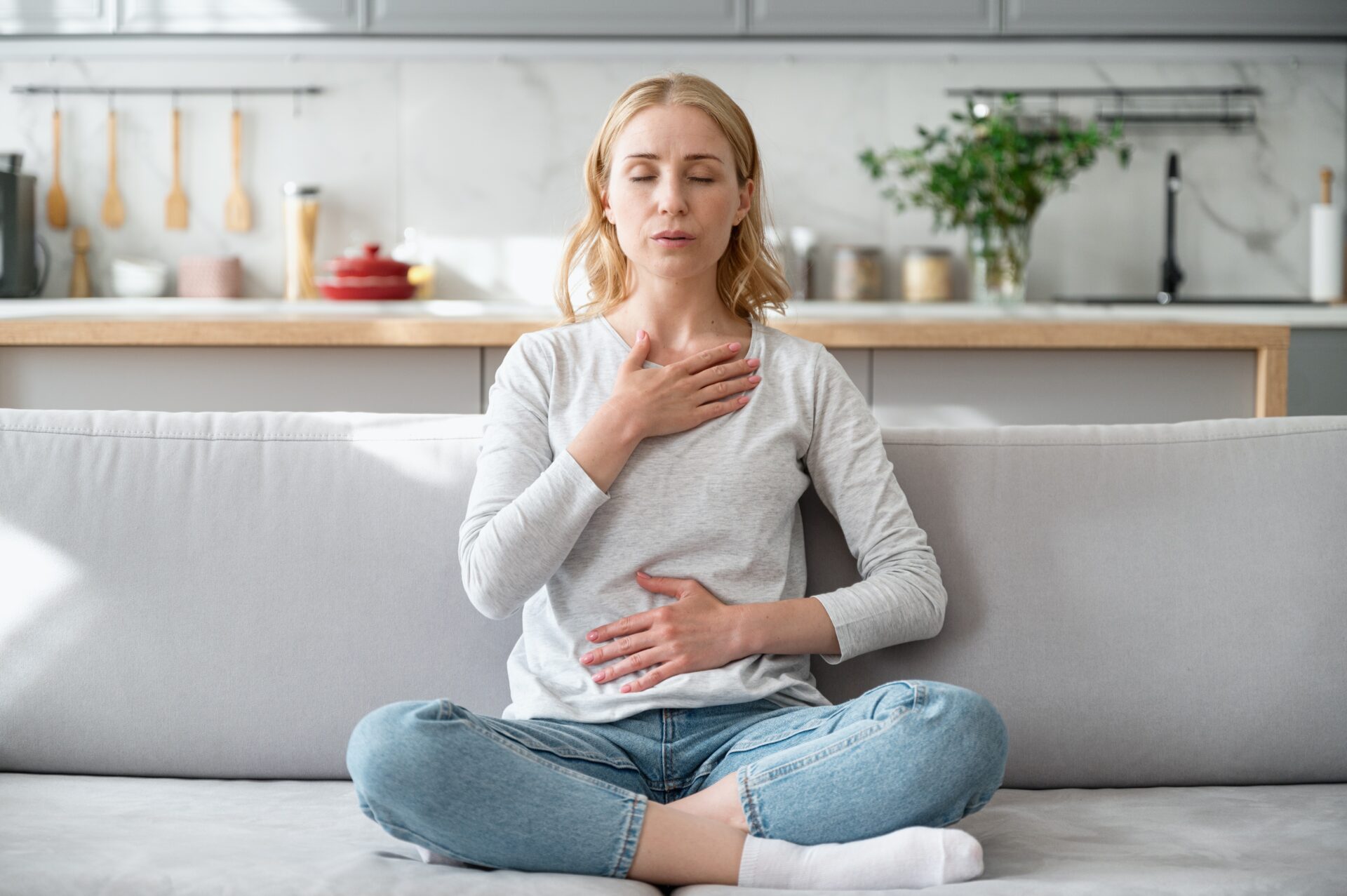By understanding how anxiety works and practicing specific skills to respond to it, we can lower its intensity and build emotional resilience. This article offers five evidence-based strategies to help reduce anxiety and strengthen your ability to meet stress with clarity and care.

Describing Anxiety
Anxiety is a common experience that affects how we think, feel, and function, especially when life feels uncertain or overwhelming. It is not a flaw in character but a natural response from the body trying to protect us. While occasional anxiety can sharpen focus or prepare us to act, chronic anxiety can disrupt sleep, strain relationships, and make daily life harder to manage. It often shows up as racing thoughts, physical tension, or the urge to avoid situations that feel unpredictable. These patterns can be exhausting, but they are not permanent.
Focus on What You Can Control
Anxiety intensifies when attention is fixed on things we cannot influence. The brain, trying to protect us, searches for threats and replays scenarios in hopes of finding certainty. This mental loop feels urgent but rarely produces relief. Instead, it drains energy and deepens the sense of helplessness.
Control begins with a shift in focus. In a stressful moment, such as an unexpected spike in health insurance costs, fear and frustration are valid. But staying in those emotions can lead to paralysis. The turning point comes when we ask what is within reach. That could mean researching other options, calling a provider, or asking for guidance. These steps do not resolve the entire issue, but they create momentum. Momentum helps calm a nervous system that feels stuck.
A strong sense of control makes a measurable difference. A meta-analysis of more than 11,000 people found that those who reported higher perceived control experienced significantly lower levels of anxiety [1].
Challenge Distorted Thoughts
Anxiety often distorts how we interpret the world around us. It filters experience through fear, turning uncertainty into threat and possibility into danger. These patterns of thinking may feel automatic, but they are not facts. They are habits of mind shaped by stress, past experience, and a deep instinct to stay safe. When we begin to name and question these thoughts, we interrupt their influence and create space for more grounded responses.
Distorted thoughts are common and recognizable once we learn what to look for. Many people find themselves assuming failure, expecting judgment, or magnifying mistakes until they feel unmanageable. These thought patterns can feel true, but they rarely reflect the full picture. Some of the most frequent examples include:
- Catastrophizing: imagining the worst-case outcome and treating it as inevitable.
- Black-and-white thinking: viewing situations as entirely good or bad, with no middle ground.
- Mind reading: believing you know what others think, often assuming the worst.
- Fortune telling: predicting negative outcomes without clear evidence.
These patterns are a core focus in cognitive behavioral therapy [2]. By learning to challenge distortions, we begin to respond with more clarity and less fear. For instance, instead of fixating on what went wrong in a conversation or job interview, you might also consider what went well and what you would improve next time. This practice takes time, but it builds emotional flexibility. Each time you step back from a distorted thought, you give yourself a different path forward. That path reflects your values, not your anxiety.
Research supports the effectiveness of this approach. In a review of over 200 studies, cognitive behavioral therapy was shown to significantly reduce anxiety symptoms across age groups and clinical diagnoses [2].
Practice Mindfulness
Anxiety often pulls our attention away from the present moment, urging the mind to dwell on past regrets or future worries. This mental drift can amplify stress and create a cycle of rumination. Mindfulness offers a way to interrupt this pattern by anchoring us in the here and now, fostering a sense of calm and clarity.
Mindfulness involves paying deliberate attention to our thoughts, feelings, and bodily sensations without judgment [3]. This practice doesn’t aim to eliminate anxiety but to change our relationship with it. By observing our experiences with openness and curiosity, we can reduce the intensity of anxious thoughts and respond to them more skillfully.
A study published in JAMA Psychiatry found that mindfulness-based stress reduction was as effective as escitalopram, a commonly prescribed antidepressant, in reducing anxiety symptoms [4]. Both groups showed about a 30 percent reduction in symptom severity, reinforcing mindfulness as a viable, evidence-based option.
To incorporate mindfulness into daily life, consider these exercises:
- Mindful breathing: Focus on the sensation of your breath entering and leaving your body.
- Body scan meditation: Move your attention gradually through your body, noticing sensation.
- Walking meditation: Walk slowly and focus on each step and physical movement.
- Mindful eating: Pay full attention to the taste, texture, and rhythm of your meals.
- Three senses exercise: Identify three things you see, hear, and feel to ground yourself.
These techniques help anchor awareness and support a more stable inner environment, even during moments of anxiety.
Learn to Breathe
The physical symptoms of anxiety are driven by the body’s stress response. Shallow breathing, a rapid heart rate, and muscle tension are part of this pattern. While these reactions are meant to protect, they can also increase the intensity of anxious feelings. When the breath remains fast and uneven, it reinforces the idea that something is wrong, even when no immediate threat is present.
Diaphragmatic breathing helps regulate this response by activating the parasympathetic nervous system, which supports calm and recovery. This technique involves breathing deeply into the lower abdomen rather than the chest. To practice it:
- Inhale slowly through the nose to let your abdomen spread.
- Pause briefly, and hold your breath.
- Exhale steadily through the mouth, allowing your body to release tension.
In a 2023 clinical trial published in Cell Reports Medicine, individuals who practiced daily breathwork experienced a greater reduction in anxiety symptoms than those who practiced mindfulness meditation [5]. The study found that just five minutes a day was enough to produce a meaningful effect. These results highlight breathwork as a practical and evidence-based option for managing anxiety.
Care for Your Whole Self
When basic needs are overlooked, anxiety becomes harder to regulate and recovery takes longer. Sleep, nutrition, physical activity, and rest are not extras. They are the conditions that help the nervous system stay balanced. Without this foundation, the brain processes stress less effectively, and even routine challenges can begin to feel overwhelming.
Foundational routines make a measurable difference:
- Sleep: improves emotional regulation and cognitive clarity.
- Physical activity: lowers stress levels and strengthens resilience over time [6].
- Balanced meals: that include protein, fiber, and complex carbohydrates help maintain steady blood sugar, which supports mood and focus [7].
- Reducing alcohol, caffeine, and nicotine: can further stabilize the system.
These habits increase your capacity to manage anxiety. Research shows that consistent self-care can reduce anxiety symptoms significantly, especially when paired with therapeutic strategies. Caring for your body is not a shortcut or escape. It is a way to prepare yourself to respond, not just react.
Moving Forward with Confidence
Anxiety becomes more manageable when we respond to it with intention rather than urgency. The strategies outlined here are not quick solutions, but they offer practical tools that support emotional steadiness over time. Refocusing attention, challenging anxious thoughts, practicing mindfulness, using the breath, and reinforcing your physical wellbeing all contribute to a more stable internal environment. Each one provides a way to interrupt reactivity and regain a sense of control.
Change takes practice. These skills may feel unfamiliar at first, but with repetition, they begin to create new patterns in how the body and mind respond to stress. You do not need to apply them all at once. Choosing one and using it consistently is often enough to create meaningful progress. Progress is not about staying calm at all times. It is about knowing how to return to center when anxiety pulls you off balance. Each return strengthens your ability to respond with confidence.
- Gallagher, M. W., Bentley, K. H., & Barlow, D. H. (2014). Perceived control and vulnerability to anxiety disorders: A meta-analytic review. Cognitive Therapy and Research, 38(6), 571–584. https://doi.org/10.1007/s10608-014-9624-x. Accessed May 25 2025.
- Beck, A. T., & Haigh, E. A. P. (2014). Advances in cognitive theory and therapy: The generic cognitive model. Annual Review of Clinical Psychology, 10, 1–24. https://doi.org/10.1146/annurev-clinpsy-032813-153734. Accessed May 25 2025.
- Arch, J. J., & Craske, M. G. (2006). Mechanisms of mindfulness: Emotion regulation following a focused breathing induction. Behaviour Research and Therapy, 44(12), 1849–1858. https://doi.org/10.1016/j.brat.2005.12.007. Accessed May 25 2025.
- Hoge, E. A., et al. (2022). Mindfulness-based stress reduction vs. escitalopram for the treatment of anxiety disorders: A randomized clinical trial. JAMA Psychiatry, 80(1), 13–21. https://doi.org/10.1001/jamapsychiatry.2022.3679. Accessed May 25 2025.
- Huberman, A. D., Spiegel, D., & Yehuda, R. (2023). Brief structured breathwork outperforms mindfulness meditation for reducing anxiety. Cell Reports Medicine, 4(1), 100895. https://doi.org/10.1016/j.xcrm.2022.100895. Accessed May 25 2025.
- Stonerock, G. L., Hoffman, B. M., Smith, P. J., & Blumenthal, J. A. (2015). Exercise as treatment for anxiety: Systematic review and analysis. Annals of Behavioral Medicine, 49(4), 542–556. https://doi.org/10.1007/s12160-014-9685-9. Accessed May 25 2025.
- Molendijk, M., et al. (2018). Diet quality and depression risk: A systematic review and dose–response meta-analysis of prospective studies. Journal of Affective Disorders, 226, 346–354. https://doi.org/10.1016/j.jad.2017.09.022. Accessed May 25 2025.
The Clinical Affairs Team at MentalHealth.com is a dedicated group of medical professionals with diverse and extensive clinical experience. They actively contribute to the development of content, products, and services, and meticulously review all medical material before publication to ensure accuracy and alignment with current research and conversations in mental health. For more information, please visit the Editorial Policy.
MentalHealth.com is a health technology company guiding people towards self-understanding and connection. The platform provides reliable resources, accessible services, and nurturing communities. Its purpose is to educate, support, and empower people in their pursuit of well-being.
Gary Gilles is a Licensed Clinical Professional Counselor in private practice for over 20 years. He is also an adjunct faculty member at the University of Chicago's School of Social Service Administration, Trinity International University and Argosy University.
Jesse Hanson, Ph.D., is a somatic psychologist with more than 20 years of experience in clinical psychology and neuropsychology.
The Clinical Affairs Team at MentalHealth.com is a dedicated group of medical professionals with diverse and extensive clinical experience. They actively contribute to the development of content, products, and services, and meticulously review all medical material before publication to ensure accuracy and alignment with current research and conversations in mental health. For more information, please visit the Editorial Policy.
MentalHealth.com is a health technology company guiding people towards self-understanding and connection. The platform provides reliable resources, accessible services, and nurturing communities. Its purpose is to educate, support, and empower people in their pursuit of well-being.


